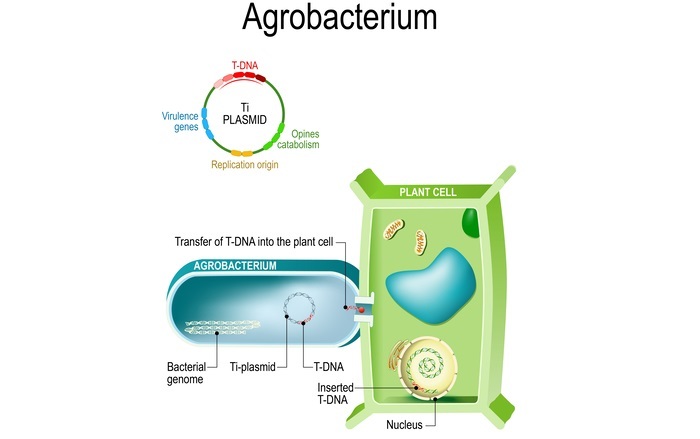
 Data Structure
Data Structure Networking
Networking RDBMS
RDBMS Operating System
Operating System Java
Java MS Excel
MS Excel iOS
iOS HTML
HTML CSS
CSS Android
Android Python
Python C Programming
C Programming C++
C++ C#
C# MongoDB
MongoDB MySQL
MySQL Javascript
Javascript PHP
PHP
- Selected Reading
- UPSC IAS Exams Notes
- Developer's Best Practices
- Questions and Answers
- Effective Resume Writing
- HR Interview Questions
- Computer Glossary
- Who is Who
Plant Transformation and Its Methods
Introduction
Plant transformation is the process of introducing foreign genes or genetic material into the genome of a plant, resulting in a genetically modified organism (GMO).

It is a powerful tool that has revolutionized the field of plant biotechnology, allowing scientists to develop crops that are resistant to pests and diseases, have higher yields, and are able to grow in adverse environmental conditions. Discussed below are the various methods of plant transformations widely used.
Agrobacterium - Mediated Transformation
Agrobacterium-mediated transformation is the most widely used method for plant transformation. It involves the use of a soil bacterium called Agrobacterium tumefaciens, which has the ability to transfer a segment of its DNA, called the T-DNA, into the plant genome.
The T-DNA is usually flanked by two border sequences, which are recognized by the bacterium's VirD2 and VirE2 proteins, allowing it to be transferred into the plant cell.
The first step in agrobacterium-mediated transformation is to prepare the plant tissue for transformation. This can be done by either using embryogenic tissue, such as immature embryos, or by using explants, which are small pieces of plant tissue.

The explants are then cultured in a medium containing a hormone called auxin, which induces the formation of callus tissue. Once the callus tissue has formed, it is exposed to an agrobacterium strain that has been modified to carry the desired gene of interest on the T-DNA.
The agrobacterium is then allowed to infect the plant tissue, transferring the T-DNA into the plant genome. The transformed tissue is then selected using antibiotics or herbicides that kill off the untransformed tissue, resulting in the growth of transgenic plants.
Biolistic Transformation
Biolistic transformation, also known as particle bombardment or gene gun transformation, is another method of plant transformation. It involves the use of a gun-like device that fires tiny particles coated with DNA into the plant tissue, allowing the foreign genes to be incorporated into the plant genome.
The first step in biolistic transformation is to prepare the DNA-coated particles. This is usually done by coating tiny gold or tungsten particles with the gene of interest, which is then loaded into the gene gun. The plant tissue is then exposed to the gene gun, which fires the particles into the tissue, allowing the foreign DNA to be incorporated into the plant genome.
Biolistic transformation has several advantages over agrobacterium-mediated transformation. One of the main advantages is that it can be used on both dicotyledonous and monocotyledonous plants, making it a more versatile method of plant transformation.
However, biolistic transformation also has some limitations. One of the main limitations is that it can result in random integration of the foreign DNA into the plant genome, which can lead to unpredictable effects on the plant's phenotype.

Electroporation
Electroporation is a method of plant transformation that involves the use of electric fields to introduce foreign DNA into the plant cell. The electric fields create temporary pores in the cell membrane, allowing the foreign DNA to enter the cell and integrate into the plant genome.
The first step in electroporation is to prepare the plant tissue for transformation. This is usually done by using embryogenic tissue or protoplasts, which are plant cells that have had their cell walls removed. The protoplasts are then suspended in a solution containing the foreign DNA and exposed to an electric field, which causes the DNA to enter the cell.
Electroporation has several advantages over other methods of plant transformation. One of the main advantages is that it can be used on a wide range of plant species, including both dicotyledonous and monocotyledonous plants.
However, electroporation also has some limitations. One of the main limitations is that it can cause damage to the plant tissue, which can affect the viability of the transformed cells.
Microinjection
Microinjection is a method of plant transformation that involves the use of a fine needle to inject foreign DNA directly into the plant cell.

The first step in microinjection is to prepare the plant tissue for transformation. This is usually done by using embryogenic tissue or protoplasts, which are plant cells that have had their cell walls removed. The protoplasts are then suspended in a solution containing the foreign DNA and injected with the needle, which allows the DNA to enter the cell.
Microinjection has several advantages over other methods of plant transformation. One of the main advantages is that it allows for precise control over the injection process, which can result in a high transformation efficiency.
However, microinjection also has some limitations. One of the main limitations is that it can be a time-consuming and labour-intensive process, as each cell must be injected individually. Additionally, microinjection can cause damage to the plant tissue, which can affect the viability of the transformed cells.
Applications of Plant Transformation
Plant transformation has numerous applications in the field of plant biotechnology.
One of the main applications is the development of crops that are resistant to pests and diseases. This is usually achieved by introducing genes that encode for proteins that are toxic to the pests or that confer resistance to the plant against specific diseases.
Another application of plant transformation is the development of crops that have higher yields or are able to grow in adverse environmental conditions. This is usually achieved by introducing genes that control the plant's growth and development, or that allow the plant to withstand abiotic stress factors such as drought, heat, or cold.
Plant transformation is also used in the production of plant-based pharmaceuticals, such as vaccines or antibodies. This is usually achieved by introducing genes that encode for the desired protein, which can then be extracted from the plant tissue and purified for use in human or animal medicine.
Conclusion
Plant transformation is a powerful tool that has revolutionized the field of plant biotechnology, allowing scientists to develop crops that are resistant to pests and diseases, have higher yields, and are able to grow in adverse environmental conditions.

